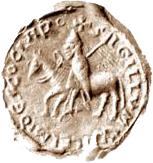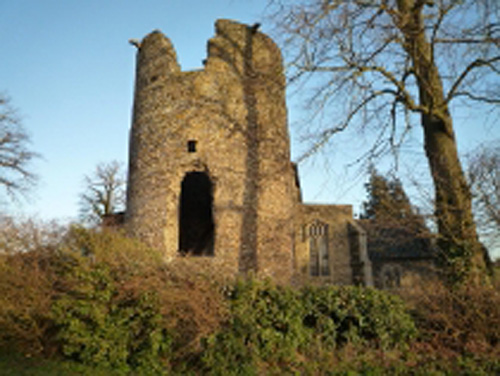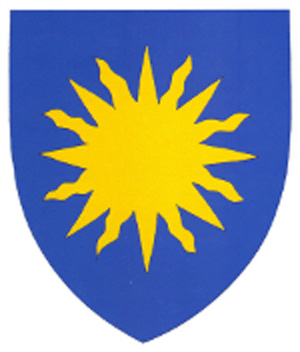Richard de Saint Clair
Ric’ard de sencler is first named as the owner of a house in Norwich in 1075. In the Domesday survey of 1086, he is recorded as holding two lordships: Wortham in Suffolk and Lexham in Norfolk. Wortham had two churches at the time, and the one that has survived is attached to a tower that was probably built at the same time as the church during the twelfth century.The two churches at Lexham, like Wortham, both have towers, a feature specific to East Anglia.
In Wortham, Richard held 45 acres as a manor from Ralph de Beaufour, and it increased in value from 40s before 1066 to 100s in 1086. In Lexham, his manor was larger, 105 acres, and included a mill and a fishery. It was recorded that Richard gave his rights in the church at West Lexham to the monks at Castleacre, just a few miles away. He also gave lands and tithes to the church at Gressenhall, another nearby Norfolk vill.
In 1121-22, Richard de Saint Clair gave his daughter to the nunnery at Shaftesbury in Dorset. This was not a surprising decision for wealthier Normans, because it guaranteed the safety of their daughters and they joined the company of many other very well connected young women, especially those at Shaftesbury. As an aid to the nunnery, he also gifted it 30 acres from his lands at Wortham. By 1122, Richard would have been quite elderly and could have been securing his daughter’s future if she was still unmarried at the time. His choice of Shaftesbury might also have been influenced by knowing that his brother Bretel held many estates and manors in Somerset and Dorset, particularly Stoke Trister, which was less than 10 miles away.
Gilbert de Saint Clair held two fees from the abbot of St. Edmundsbury in 1166. Richard de Saint Clair was named in Henry II’s Pipe Roll in 1176-77, and in 1190, he sold land at Marlingford (near Norwich) to Osbert de Wachesham. Gerebert de Saint Clair provided two knights to one of the four constables at St. Edmundsbury around 1200, one of whom was Robert de Saint Clair, and possibly his brother. Gerebert released all his rights at Wortham to Osbert de Wachesham in 1207, and established himself at Bradfield St. Clare, a few miles south of St. Edmundsbury.
Bardfield St. Clare became the principal manor of Richard de Saint Clair’s descendants in Norfolk and Suffolk during the next century, where they created a deer park.
| 1 | 2 | 3 | 4 | 5 | 6 | 7 | 8 | 9 | 10 | generations | |
| Richard de Sancto Claro, of Wortham and Lexham (c.1045-c.1122) | |||||||||||
| daughter, entered Shaftesbury nunnery, 1121-22 | |||||||||||
| Gilbert, d. after 1166 | |||||||||||
| Richard, fl.1176-1191 | |||||||||||
| Robert, constable at St. Edmundsbury, c.1200 | |||||||||||
| Gerebert, of Bradfield St. Clare and Wattisfield (c.1174-1252) | |||||||||||
| John (-1252) | |||||||||||
| Robert | |||||||||||
| Edmund | |||||||||||
| John (c.1234-after 1302) | |||||||||||
| John m. ?Beauchamp | |||||||||||
| Guy (Guido) m. Marjory [Margaret] | |||||||||||
| Sheriff of Cambridgeshire and Huntingdonshire (1349) | |||||||||||
| Sheriff of Norfolk and Suffolk (1357-59) | |||||||||||
| Pain (Paganus), of Grimston, d. after 1376 | |||||||||||
| ?Joan m. Edward de St. John | |||||||||||


